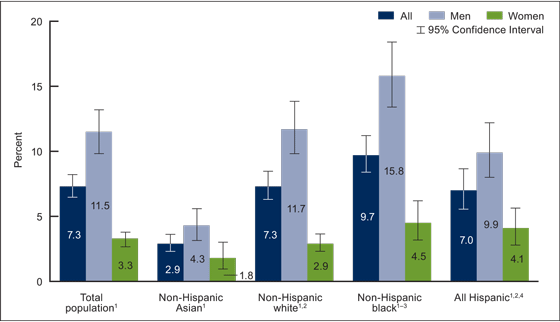Prevalence of HPV in Adults Aged 18–69: United States, 2011–2014
Posted on byQuestions for Geraldine McQuillan, Ph.D., Statistician, and Lead Author of “Prevalence of HPV in Adults Aged 18–69: United States, 2011–2014”
Q: Are these the first HPV estimates you’ve released? If not, how has this problem changed over time?
GQ: In this report we do not examine changes over time. But based on a report authored by one of our Co-authors, Dr. Markowitz, analyzing previously released NHANES data, since the highly efficaciously vaccine against HPV 6,11 and 18 was introduced in 2006, the prevalence of high risk HPV in female adolescents has decreased by 64% and among females age 20-24 years by 34%.
Q: What do you think is the most striking finding in your report?
GQ: That over 20% of the adult population of the US have high risk HPV detected with significant race/ethnic differences.
Q: What are we to make of the relatively low HPV prevalence numbers among Asians? Are they less promiscuous/sexually active?
GQ: This is a brief report that provides estimates on HPV prevalence overall and by race/ethnic differences. We did not further examine the characteristics of these individuals and cannot speculate on why the prevalence may be lower among Asian adults.
Q: Your report talks about people with “high risk” HPV being at a higher risk for cancer – but what is the difference between low risk HPV and high risk HPV? How is that determined medically?
GQ: It is not determined medically but by a laboratory test looking at subtypes that are associated with cancer. High risk subtypes have been associated with oral, genital and anal cancers, while low risk types have been associated with warts.
Q: Are people with genital HPV at a higher risk to contract other STIs, including HIV?
GQ: We again did not examine this in the current report, but based on prior research, we know that men who have HIV and men who have sex with men are at particular risk for anal, penile and throat cancers due to persistent HPV infection.
Q: What are the current recommendations for HPV vaccine?
GQ: According to Dr. Lauri Markowitz with the CDC’s National Center for Immunization and Respiratory Diseases, CDC recommends two doses of HPV vaccine for 11 and 12 year olds to prevent HPV cancers. Younger adolescents need fewer doses to complete the HPV vaccination series compared to older adolescents. The first dose is recommended at 11-12 years old. Vaccination can be started at age 9. The second dose of the vaccine should be administered 6 to 12 months after the first dose. Teens and young adults who start the series at ages 15 through 26 years need three doses of HPV vaccine to protect against cancer-causing HPV infections. Adolescents aged 9 through 14 years who have already received two doses of HPV vaccine less than 5 months apart, will require a third dose. Three doses are recommended for people with weakened immune systems aged 9-26 years. Here’s a link to the press release that describes the changes: https://www.cdc.gov/media/releases/2016/p1020-hpv-shots.html
Q: What other findings in your report did you find striking?
GQ: That among all race/ethnic groups males were significantly more likely to be infected with oral HPV except for high risk HPV among Asian adults.
Posted on by


